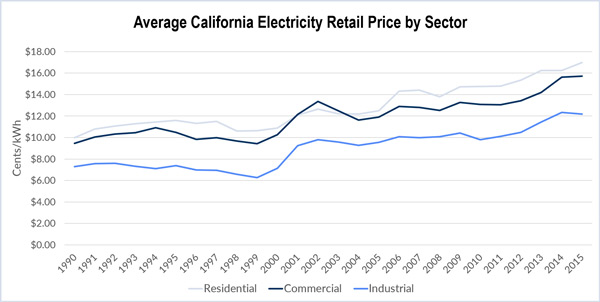By Robert Mullin
More than two decades after initiating a deregulation drive that faltered in the wake of the Western Energy Crisis of 2000/01, California officials are taking another look at offering consumers the ability to choose their electric supplier.
This go-round should be different, according to the state agencies heading up a new exploration of “the changing state of retail choice” in California, because of changes already in motion.
“Unlike electricity restructuring efforts of the past, when policymakers made a set of conscious decisions to move to open market competition, this transition is being driven by a range of economic and technological trends,” the California Public Utilities Commission and California Energy Commission said in a joint statement April 11.
To kick off the effort, the two agencies will hold a May 19 joint en banc public hearing to identify the “challenges and opportunities” stemming from “fast-approaching” changes overtaking the industry. The goal is “to ensure that reliable and low-carbon electricity will be available to all California consumers,” the agencies said.
Key among the factors now influencing the sector: the rapidly falling costs for renewable and energy storage technologies, which the CPUC and CEC say are “upending the nature of electricity service.”
The agencies estimate that by the end of this year, up to 40% of the state’s investor-owned utility customers will be receiving “some type” of electricity service from an alternative source, such as rooftop solar, community choice aggregators (CCAs) and direct access providers.
California today boasts nearly 5,200 MW of installed rooftop solar capacity, according to California Distributed Generation Statistics, a website sponsored by the CPUC and the state’s IOUs. The state also has six CCAs, with more slated to begin operation within the next few years, a development that is expected to increasingly siphon off the customer base from the traditional IOUs.
“The implications of this migration away from ‘bundled’ utility service were not fully contemplated when the current regulatory rules were developed,” the agencies said.
The changes provide “tremendous opportunities” for California to meet its carbon reduction goals, but they will also create “unforeseen risks,” the agencies said.
The May 19 hearing will offer a closer examination of those opportunities and risks. A preliminary agenda indicates the event will start with a presentation on a still-pending CPUC white paper on retail choice, followed by an overview of the current state of retail choice in California and panel discussions focused on the perspectives of both the IOUs and electricity customers.
The agencies will also invite national electricity market experts to share their perspectives on retail choice in other regions, the role of technology in transforming electricity service and how California can restructure its regulatory framework and markets to help achieve its public policy goals.
California last set a course for deregulation in 1996 with the enactment of Assembly Bill 1890. Under the law, regulators first set out to restructure the state’s wholesale market while leaving retail price controls intact. The ensuing crisis — which resulted in the 2001 bankruptcy of wholesale market operator California Power Exchange — precluded the implementation of any retail market measure. Wholesale operations now reside with CAISO, which in 2009 rolled out a nearly statewide energy market designed to prevent the kind of manipulation that crippled the exchange.





